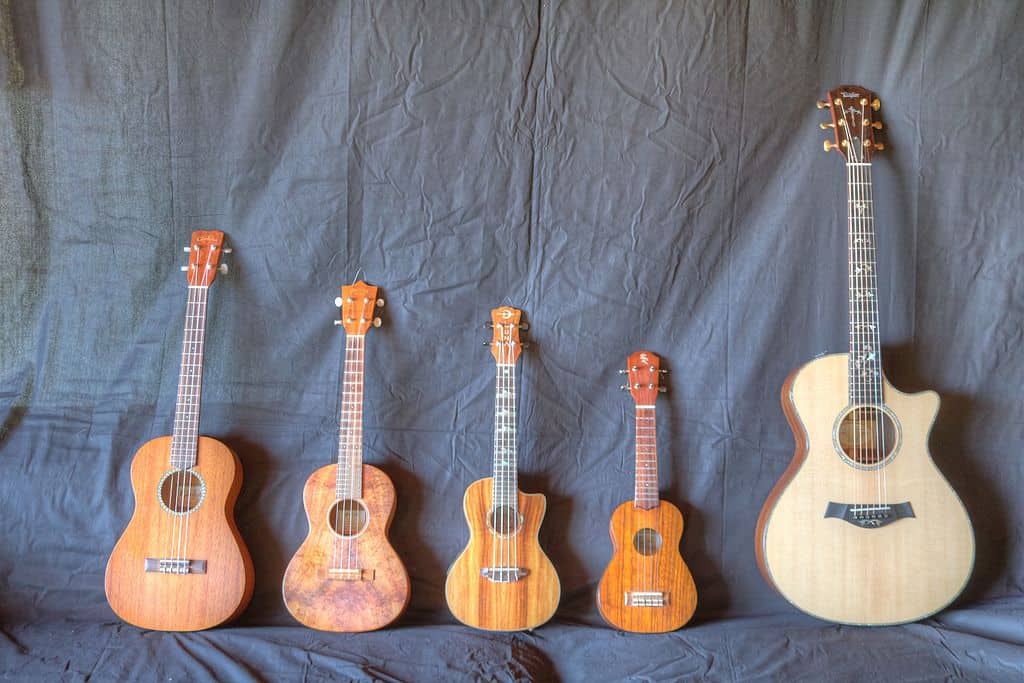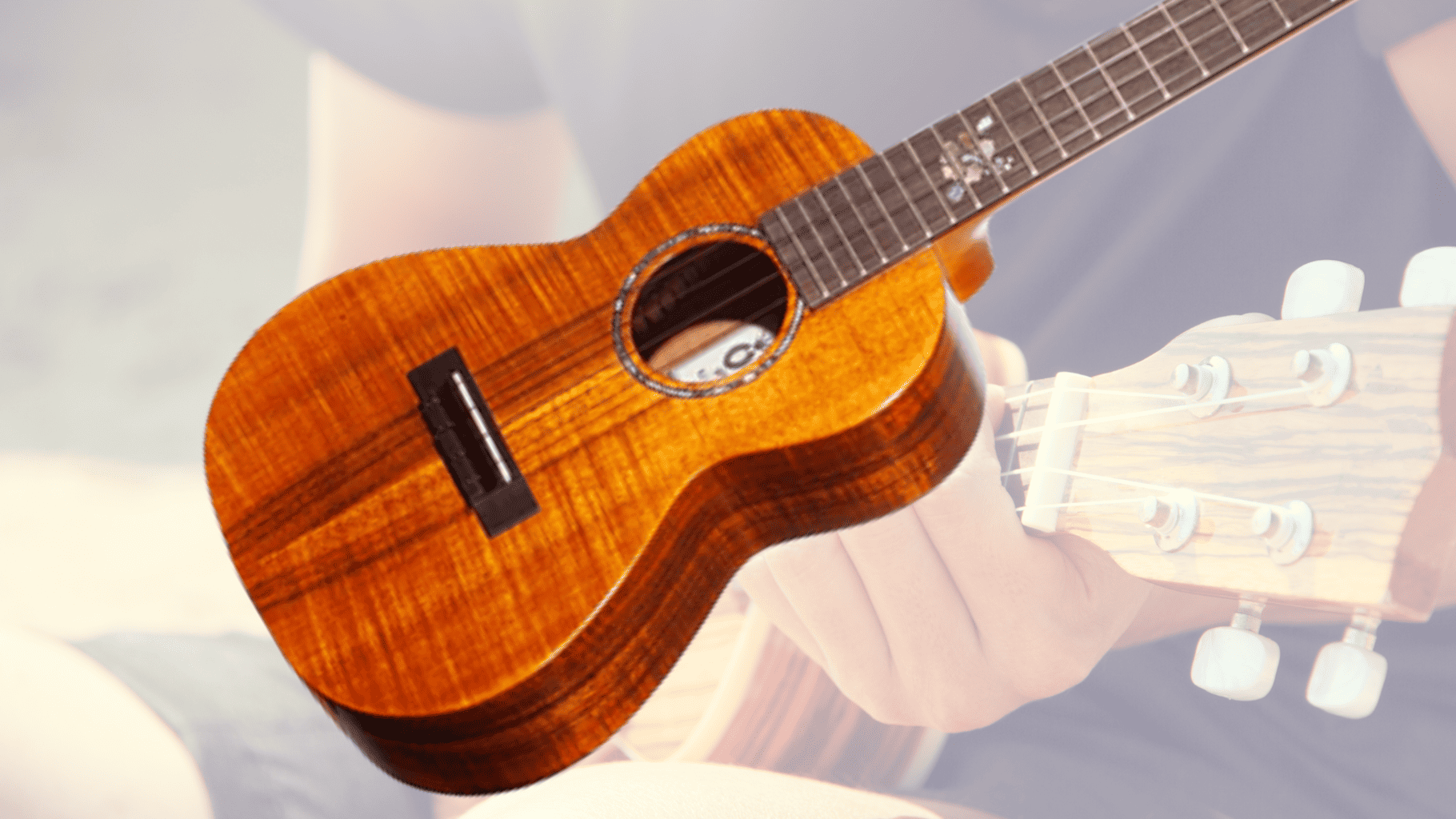A ukulele is a small, four-stringed instrument that is part of the guitar family, known for its distinct sound and portability, differing from other stringed instruments in its size and tuning.
The ukulele is a unique and enchanting musical instrument that has captured the hearts of musicians and enthusiasts around the world.
In this article, we will explore the captivating world of the ukulele, delving into its history, different types, and what sets it apart from other stringed instruments.
What is a Ukulele?
The ukulele, often referred to as simply the “uke,” is a four-stringed instrument that falls under the guitar family. Its roots trace back to the 19th century when it was developed in Hawaii, a place where music and culture intertwine seamlessly.
The word “ukulele” itself translates to “jumping flea” in Hawaiian, possibly referencing the lively and nimble fingers of its players.
How is a Ukulele Different from a guitar
A ukulele is smaller and typically has four nylon strings, while a guitar is larger and commonly has six steel or nylon strings.
Additionally, the ukulele has a distinct, brighter sound and is often associated with Hawaiian music, while the guitar offers a wider range of tones and is used in various musical genres.
Ukulele Size Matters
One of the most striking features that distinguishes the ukulele from other stringed instruments is its size. It is notably smaller than its guitar relatives, making it incredibly portable and easy to carry around. This petite size not only contributes to its charm but also plays a significant role in shaping its unique sound.

This compact design sets them apart from their larger cousins, such as the guitar and the violin. Ukuleles have a body structure reminiscent of a compact acoustic guitar.
Ukuleles are constructed with a combination of materials, including wood, plastic, and, occasionally, metal. The body of the ukulele is often made of different types of wood, which significantly influences its sound.
Common wood choices for uke bodies include mahogany, koa, and spruce. The strings are typically made of nylon. Nylon strings contribute to the instrument’s distinctive mellow and resonant sound.
Tuning and Sound
The tuning of a ukulele is another aspect that distinguishes it from other stringed instruments.
While guitars typically have six strings and are tuned to EADGBE from low to high, the ukulele has only four strings and is traditionally tuned to GCEA, from top to bottom. This unique tuning contributes to making it instantly recognizable.
The standard tuning of a soprano, concert, or tenor uke is GCEA, with the G string being the highest pitch. This unique tuning produces a bright and cheerful sound that is instantly recognizable.
For those seeking a lower, more guitar-like tone, the baritone size is an option. Its tuning is similar to the four top strings on a guitar, with DGBE (from top to bottom). This tuning provides a deeper, richer sound compared to the standard ukulele tuning.
Playability
The ukulele’s smaller size and fewer strings make it an ideal choice for beginners. Its compact fretboard is less intimidating for those just starting their musical journey, and the simplicity of chord shapes and strumming patterns allows for a quick learning curve. This accessibility makes the ukulele an excellent choice for those new to playing stringed instruments.
Playing the ukulele involves a set of techniques that are distinct from those used in other stringed instruments. Here are a few key techniques:
- Strumming: Strumming is a fundamental technique for ukulele players. The most common strumming pattern is the down-up strum, where you use your fingers or a pick to strum the strings in a continuous motion. Different strumming patterns can create a variety of rhythms and effects.
- Fingerpicking: Fingerpicking involves plucking the strings individually with your fingers. It allows for more intricate melodies and is often used in folk and classical ukulele music.
Chords: Ukuleles are known for their simplicity when it comes to playing chords. Basic chords like C, G, Am, and F are relatively easy to learn, making the ukulele an excellent choice for beginners.
Versatility
Despite its small size and unique tuning, the ukulele is a remarkably versatile instrument. It can be used in various music genres, from traditional Hawaiian melodies to pop, rock, jazz, and beyond.
Its bright and cheerful tones can evoke feelings of joy and nostalgia, making it a favorite in both solo and ensemble performances.
It can be used to play a wide range of musical genres, including:
- Folk: The ukulele’s cheerful sound complements folk music well, and it’s often used in folk ensembles.
- Pop: Many popular songs incorporate the ukulele due to its bright and catchy character.
- Hawaiian Music: As the birthplace of the ukulele, Hawaii has a rich tradition of ukulele music, which is an integral part of Hawaiian culture.
- Jazz: Some jazz musicians have embraced the ukulele, showcasing its adaptability in various musical contexts.
- Rock: Surprisingly, the ukulele has made its way into rock music, with bands and artists incorporating it into their songs for a unique sound.
Portability and Accessibility
The compact size and light weight of the ukulele make it a highly accessible instrument for people of all ages. It’s a fantastic choice for young beginners who might find larger instruments daunting. Additionally, its portability makes it a great travel companion for musicians on the go.

Portability and accessibility are two key attributes that make the ukulele a beloved musical instrument enjoyed by people of all ages and skill levels. Its compact size and featherweight design contribute significantly to its universal appeal.
First and foremost, the ukulele’s petite stature and lightweight build are perfect for introducing children and young beginners to the world of music.
Unlike larger instruments like guitars or pianos, the ukulele’s manageable size allows for a more comfortable grip and fretting for small hands.
This ease of playability not only boosts a young musician’s confidence but also fosters a sense of accomplishment, encouraging them to pursue their musical journey further.
Moreover, the ukulele’s approachability extends beyond the young learners to anyone who may feel intimidated by larger, more complex instruments.
Its four strings, as opposed to the six or twelve found on guitars, reduce the initial learning curve, making it an excellent choice for novice musicians.
This accessibility factor is particularly important in music education and therapy, as it opens doors for individuals of all ages, abilities, and backgrounds to experience the joy of making music.
In addition to being a travel companion, the ukulele’s portability also makes it ideal for impromptu jam sessions, social gatherings, and community events.
Its unassuming presence encourages people to come together, share music, and form connections, fostering a sense of unity and camaraderie among musicians and audiences alike.
Popularity and Famous Ukulele Players
Over the years, the ukulele has gained popularity worldwide thanks to its endearing sound and approachable nature. Many famous musicians have also embraced the ukulele, further elevating its status. Some notable ukulele enthusiasts and players include:
- Jake Shimabukuro: Renowned for his virtuosic ukulele skills, Shimabukuro has elevated the instrument’s profile with his captivating performances.
- Israel Kamakawiwo’ole: Known for his iconic rendition of “Somewhere Over the Rainbow,” Kamakawiwo’ole’s ukulele version of the song remains a beloved classic.
- Amanda Palmer: The singer-songwriter and former Dresden Dolls member often incorporates the ukulele into her performances.
- George Harrison: the legendary guitarist and songwriter of The Beatles, had a deep affinity for the ukulele. He was introduced to the instrument during the band’s stay in Hawaii in 1963, and it quickly became one of his favorites. George found the ukulele’s simplicity and charming sound appealing and often played it during recording sessions and private gatherings.
Types of Ukuleles: Instrument Sizes
Ukuleles come in various types, each offering its own unique sound and characteristics. Here is an overview of the most common ukulele types:
| Ukulele Type | Size | Tuning | Sound Characteristics |
|---|---|---|---|
| Soprano | Smallest | GCEA | Bright and traditional |
| Concert | Slightly larger | GCEA | Deeper and richer |
| Tenor | Larger | GCEA | Warm and full-bodied |
| Baritone | Largest | DGBE | Guitar-like and mellow |
Soprano Ukulele
The soprano ukulele is the smallest and most iconic of all ukulele types. It’s often associated with the classic, bright, and cheerful sound that the ukulele is known for.
Its small size makes it incredibly portable and easy to play, especially for those with smaller hands.
Concert Ukulele
The concert ukulele is slightly larger than the soprano, offering a bit more room on the fretboard.
This additional space allows for more comfortable finger placement and makes it a popular choice for musicians looking for a balance between portability and sound richness.
Tenor Ukulele
Stepping up in size, the tenor ukulele provides a warmer and fuller sound due to its larger body and longer scale length. This makes it a preferred choice for those seeking a more substantial tonal presence in their music.
Baritone Ukulele
The baritone ukulele is the largest of the ukulele family and is tuned differently, with the same tuning as the top four strings of a standard guitar (DGBE).
This gives it a mellow and guitar-like sound, making it a favorite for those who want a ukulele that closely resembles the guitar in terms of playability and sound.
Choosing the Right Ukulele: Get Strumming
Selecting the right ukulele is crucial to ensure an enjoyable playing experience. If you’re just starting your ukulele journey, it’s advisable to begin with a soprano or concert ukulele.
These smaller sizes are easier to handle and learn on, and their affordability makes them accessible to beginners. Look for a ukulele that fits comfortably in your hands and has good playability.
Here are some considerations based on your skill level when you play a ukulele:
Beginner Level:
- Soprano or Concert Size: Beginners often find smaller ukuleles like the soprano or concert size more comfortable to handle due to their compact dimensions. These sizes also tend to be more affordable, making them an excellent choice for those just starting.
- Affordable Materials: Opt for a ukulele made from laminate wood or other budget-friendly materials. These instruments are durable and require minimal maintenance, which is ideal for beginners still learning the ropes.
- Standard Tuning (G-C-E-A): Stick to the traditional G-C-E-A tuning, as it’s the most common and beginner-friendly. It ensures access to countless beginner tutorials and songs.
- Geared Tuners: Look for ukuleles equipped with geared tuners, as they make tuning much easier for beginners compared to friction tuners.

Intermediate to Advanced Players
Intermediate and advanced players often lean towards tenor or baritone ukuleles for their richer tonal qualities and extended fretboards.
These players might also seek out high-quality materials and craftsmanship for a more refined playing experience.
Intermediate Level:
- Concert or Tenor Size: As you progress, you may want to consider a concert or tenor size ukulele. These sizes offer a slightly larger sound and more room for finger placement, enhancing your playing experience.
- Solid Wood or Higher-Quality Materials: Intermediate players might benefit from upgrading to a ukulele with a solid wood top. Solid wood produces a richer, warmer tone compared to laminate options, providing a more nuanced sound.
- Experiment with Alternate Tunings: At this stage, you can start exploring alternate tunings to expand your musical horizons. However, ensure your ukulele can handle these tunings without straining.
- Pickup or Electronics: If you plan to perform on stage or record your music, consider a ukulele with built-in electronics or a pickup system for better sound amplification.
Advanced Level:
- Tenor or Baritone Size: Advanced players often prefer tenor or baritone ukuleles. These larger sizes offer greater projection and tonal depth, allowing for more complex playing techniques and expression.
- High-End Materials: Seek out ukuleles crafted from premium woods such as solid mahogany or koa. These materials deliver exceptional sound quality and sustain, catering to your discerning taste.
- Customization Options: Advanced players may want to explore custom ukulele options to tailor their instruments to their exact preferences, including tonewood choices, inlays, and finishes.
- Consider Unique Tunings: Embrace unique tunings to push the boundaries of your ukulele playing. Experiment with low-G, slack-key, or open tunings for distinctive sounds and possibilities.
Consider Your Budget
Budget is another crucial factor to consider before buying a ukulele. While you can find affordable options for beginners, investing in a higher-quality instrument can yield better sound and playability. Determine your budget and explore options that match your price range.

Ultimately, selecting the right ukulele is a personal journey that aligns with your skill level and musical aspirations.
By considering these guidelines based on your proficiency, you’ll be well on your way to finding the perfect ukulele companion to accompany you on your musical adventure.
Maintenance
Maintaining a ukulele is relatively straightforward. Here are some essential tips:
- Invest in high-quality accessories like a hardshell case, humidifier, and precision tuners to protect and maintain your prized ukulele.
- Keep your ukulele in a stable environment with moderate humidity to prevent cracking or warping of the wood.
- Clean the strings and fretboard regularly to remove dirt and oils that can affect the sound and playability.
- Check for loose tuning pegs or frets and address any issues promptly.
- Consider professional setup and adjustments if you notice intonation problems or uneven frets.
Conclusion: What is a Ukulele
In summary, the ukulele is a unique and endearing musical instrument that offers a unique playing experience.
Its small size, distinctive tuning, and versatility set it apart from other stringed instruments, making it accessible to musicians of all skill levels.
Whether you’re strumming sweet melodies on a soprano ukulele or exploring the depths of a baritone ukulele, the ukulele is a miniature marvel of musical magic that continues to captivate audiences worldwide.
The ukulele offers a world of musical possibilities that make it truly special. So, pick up a ukulele, strum a few chords, and discover the joy of this delightful instrument.

